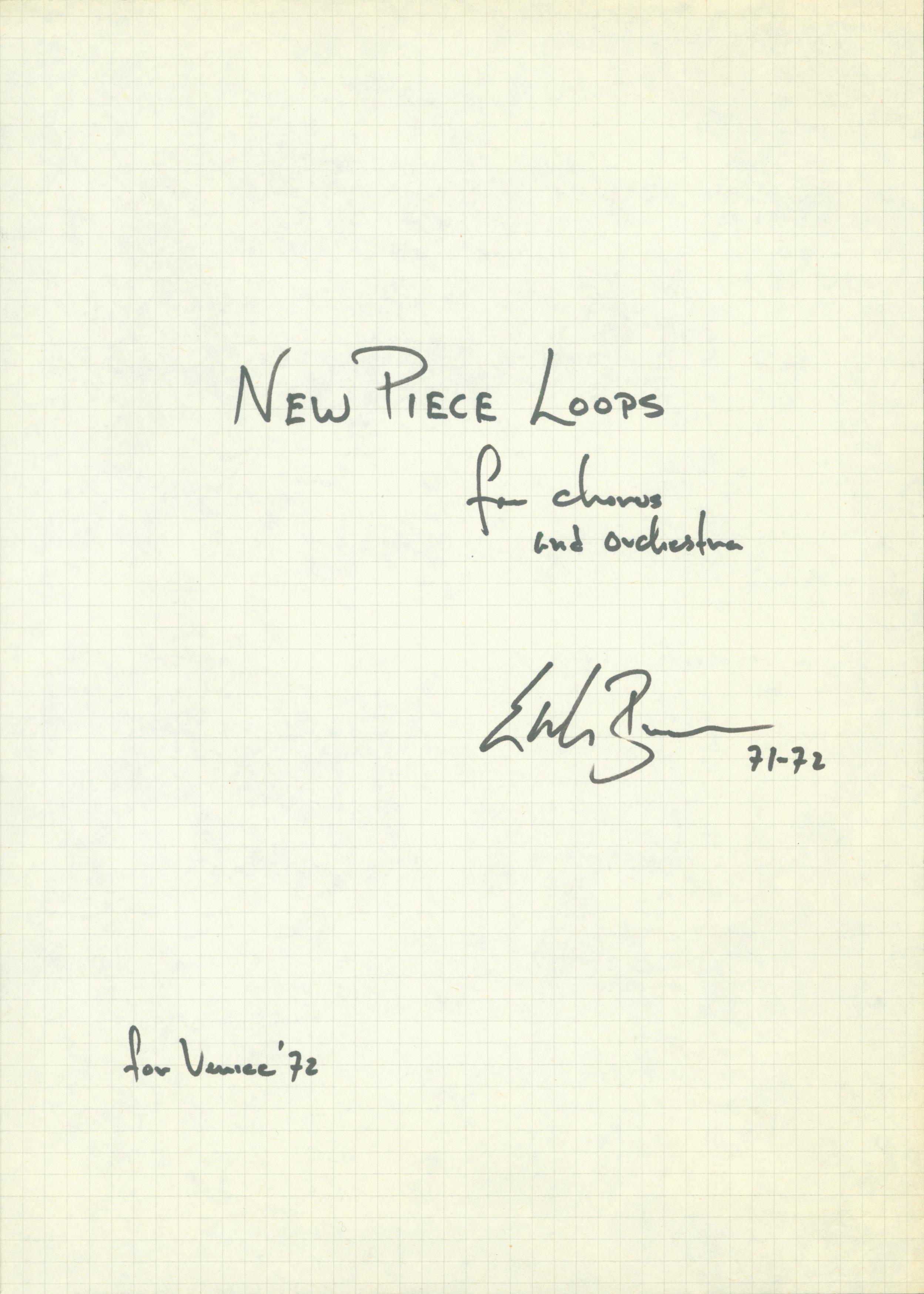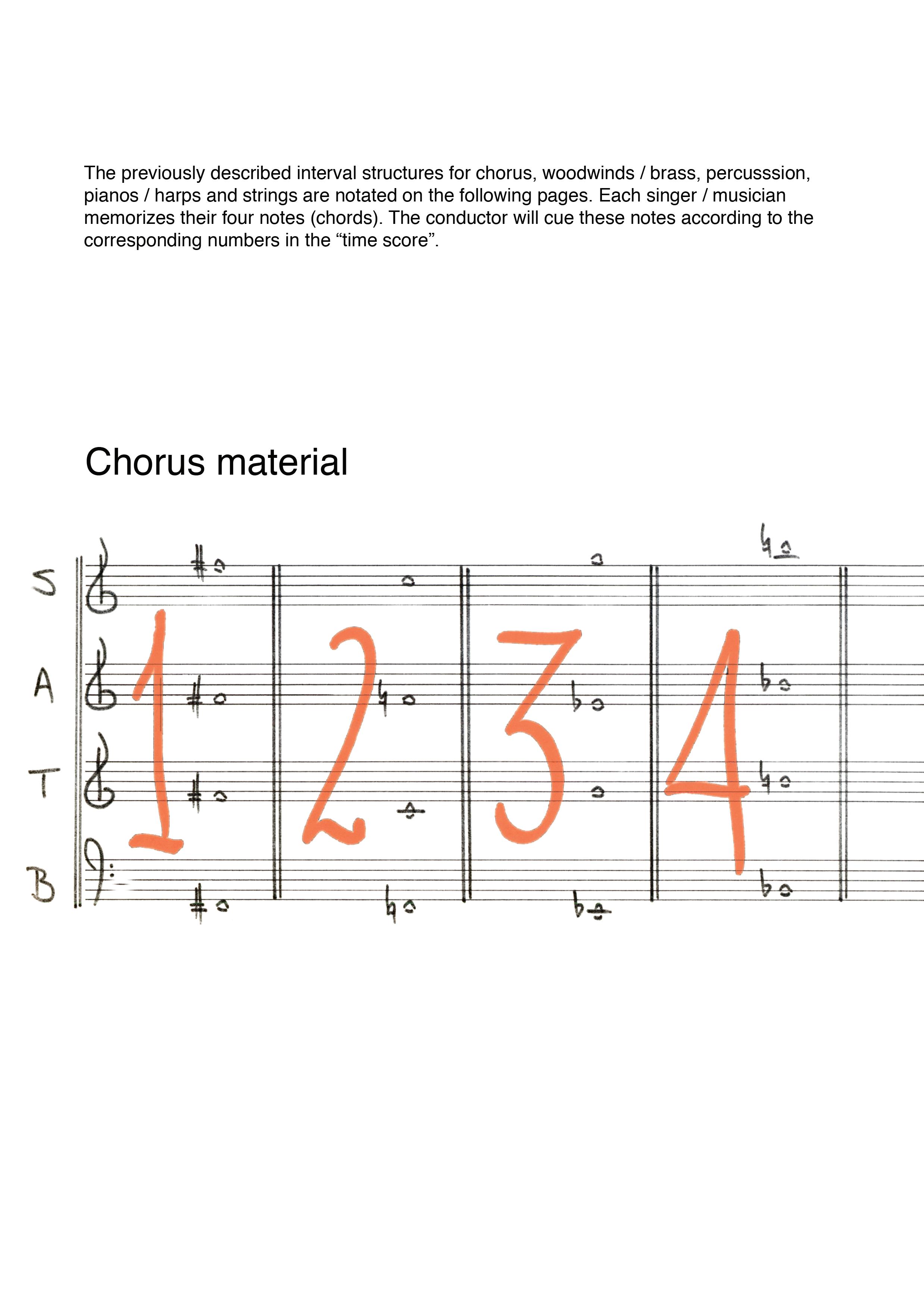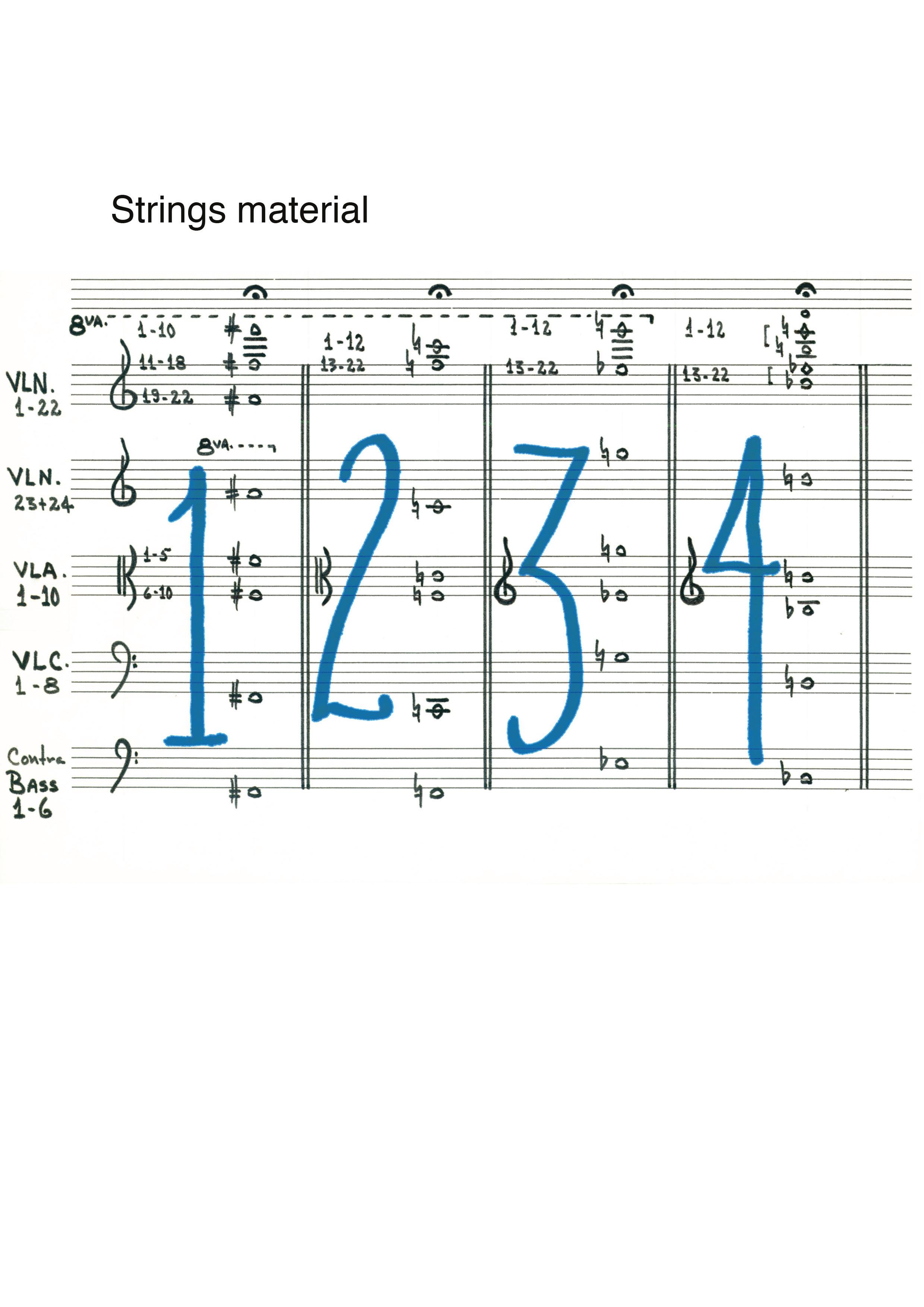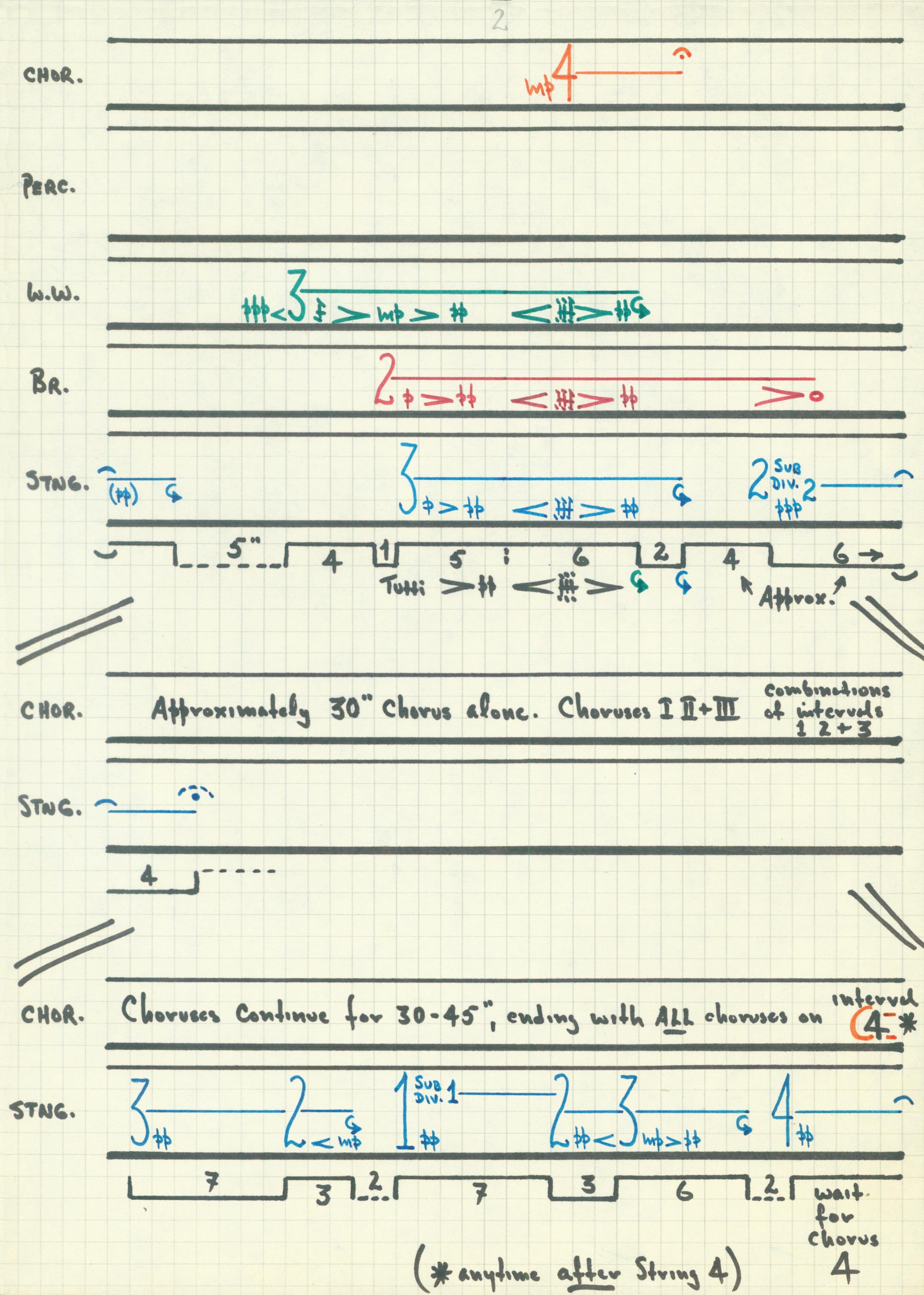BROWN
New Piece Loops
for Chorus and Orchestra
Score


Score


Commissioned by La Biennale di Venezia, Festival Internazionale di Musica Contemporanea
Sopranos
Tenors
Basses
Instrumentation
2 Flutes
1 Oboe
1 Clarinet in B b
1 Bass Clarinet
1 Bassoon
1 Contrabassoon
2 Trumpets in C
2 Horns in F
2 Trombones
2 Tubas
2 Pianos
2 Harps
2 Glockenspiels
2 Vibraphones
2 Xylophones
2 Marimbas
24 Violins 10 Violas
8 Violoncellos
6 Contrabasses
Duration: approximately 20 minutes
Germany, 1972 Score (transposed)
NEW PIECE LOOPS is based on a 1971 sketch for the 18 instruments of AVAILABLE FORMS I . In its present condition the sketch is transposed and adapted for large chorus and large orchestra. The original sketch is for the 18 instruments in 4 groups to be placed in the corners of the auditorium, with the conductor in the center. When space permits I ask that the large chorus and orchestra be similarly distributed but I don’t insist upon this condition. Since STRING QUARTET (1965) and MODULES I+II (1966) I have been working toward a simplification of the materials in the works. I have written graphic scores and scores for collective improvisations and for all combinations of control, open form, performer interpretation, etc., since 1952 , and will continue to work with these conditions in future works. However, now that these kinds of scores and performance practices have become the clichés of today’s music (and extremely boring for the most part) I prefer to move my work in another direction. Random sound (as beautiful as it can be) is as boring and academic in 1972 as neo-classicism was in 1952 NEW PIECE LOOPS is based on 4 simple intervals. This of course may also be boring but for me it is more of a challenge and a less over-indulged area for exploration.
Earle Brown
Kiel,
Chorus Instructions
Minimum 48 voices:
Soprano
Alto
Tenor 12 Bass
divided in 3 distinct choruses of 4S, 4A, 4T, 4B. Each must be placed on a single plane, but as far apart as possible:
2 3 1
Conductor
The conductor must be able to cue each chorus separately and clearly, with no visual confusion for the individual choruses.
Each chorus has only the same four interval structures:
Structure 1 = octaves
Structure 2 = 5 ths
Structure 3 = 10 ths
Structure 4 = minor 9 ths
The choral conductor will assign various VOWEL sounds to each section of each chorus: 4 different vowel sounds in each chorus, and they may be the same or different vowels for each of the 3 (or 4 ) Soprano, Alto, Tenor, Bass sections. The assigned vowels should be the most comfortable for the singers to sustain relative to the register of the notes, the acoustics of each interval structure and the native language of the singers.
The conductor will indicate which of the interval structures is to be sung by showing 1 to 4 fingers of the LEFT hand as a preparation ; a normal downbeat with the RIGHT hand indicates that S-A-T-B of that chorus will sing on the downbeat. Loudness is indicated by the size and speed of the downbeat. The conductor may prepare 2 or more similar or different interval structures by left-hand indications and give
a single downbeat to achieve a single simultaneous attack by 2 or more choruses. Stopping or loudness modifications may likewise be collective or individual. Two-hand cutoff stops entire chorus: one-hand cut-off stops only the indicated chorus or choruses. A rigid right hand chopping motion by the conductor indicates a single, non -sustained attack (percussive).
Subdivisions of each interval structure may or may not be made by fingers of the RIGHT hand (simultaneous with LEFT -hand preparation of the structure desired):
RIGHT -hand fingers: 1 = Sopranos
2 = Altos
3 = Tenors
4 = Basses
(One finger, followed quickly by four fingers shown to a chorus, followed by a downbeat would sound only Sopranos + Basses.)
There must be no less than two pitches in any structure. The combination of Alto + Bass [or Tenor and Soprano] must not be used!
STAGE D ISTRIBUTION
The orchestra is divided into five primary sections:
Percussion I Percussion II
Woodwinds Brass Strings
The score consists of four interval-structures:
Structure 1 = octaves
Structure 2 = 5 ths
Structure 3 = 10 ths
Structure 4 = minor 9 ths
The conductor indicates which orchestral section he wishes to hear by pointing to that section with the left hand to the following stage areas:
Percussion I
Percussion II
Woodwinds
Brass
HIGH signal to the LEFT
HIGH signal to the RIGHT
MEDIUM signal to the LEFT
MEDIUM signal to the RIGHT Strings
LOW signal to the CENTER
The conductor will indicate which of the interval-structures is to be played by showing 1 to 4 fingers of the LEFT hand to the orchestral section, as a preparation ; a normal downbeat with the RIGHT hand will indicate that that section will play on the downbeat. The conductor may prepare 2 or more similar or different interval-structures from different sections by LEFT -hand signals and give a single downbeat to achieve a single simultaneous attack by 2 or more orchestral sections. The size and speed of the conductor’s downbeat will indicate relative loudness. Stopping or modifications of loudness may be collective or to individual sections: a two-hand cut-off stops the entire orchestra; a one-hand cut-off stops only the section to which the hand (left or right) is pointing. The same conditions apply to
modifications of loudness. A rigid right hand in a chopping motion by the conductor indicates a single, non-sustained attack, in a percussive manner. (Strings may play pizzicato , if conductor wishes.)
All structures are to be held until cut-off or another structure is given (percussion strike only once, L.V., for each downbeat).
Subdivisions of each interval structure may or may not be made by fingers 1 to 5 of the RIGHT hand (simultaneous with the LEFT -hand preparation of the orchestral section desired).
RIGHT-hand fingers :
Percussion
1 = Piano I & Piano II
2 = Harp I & Harp II
3 = G-V I & G-V II
4 = X-M I & X-M II
5 = ALL Perc. RANDOMIX
Woodwind
1 = 2 Flt. & Oboe
2 = B b Cl. & Bass Cl.
3 = Bsn. & C. Bsn.
Brass 1 = 2 Trpt. & 2 Hrn.
2 = 2 Tbn. & 2 Tba.
Strings 1 = Vln. 1-22
2 = Vln. 23-24 & Vla. 1-10
3 = Vlc. 1-8
4 = C. Bass 1-6

The previously described interval structures for chorus, woodwinds, bass, percussion, pianos, harps and strings are notated on the following pages. Each singer / musician memorizes his or her four notes (chords). The conductor will cue these notes according to the corresponding numbers in the “time score.”












Earle Brown was born in 1926 in Lunenburg, Massachusetts, and in spirit remained a New Englander throughout his life. A major force in contemporary music and a leading composer of the American avantgarde since the 1950s, he was associated with the experimental composers John Cage, Morton Feldman and Christian Wolff, who – together with Brown – came to be known as members of the New York School. Brown died in 2002 at his home in Rye, New York.
Earle Brown wurde 1926 in Lunenburg, Massachusetts, geboren und blieb im Geist ein Leben lang Neuengländer. Ab den 1950er Jahren war er eine treibende Kraft in der zeitgenössischen Musik und einer der führenden Komponisten der amerikanischen Avantgarde. Enge Verbindung unterhielt er zu den experimentellen Komponisten John Cage, Morton Feldman und Christian Wolff, mit denen gemeinsam er später der sogenannten New York School zugerechnet wurde. Brown starb 2002 in seinem Haus in Rye, New York.